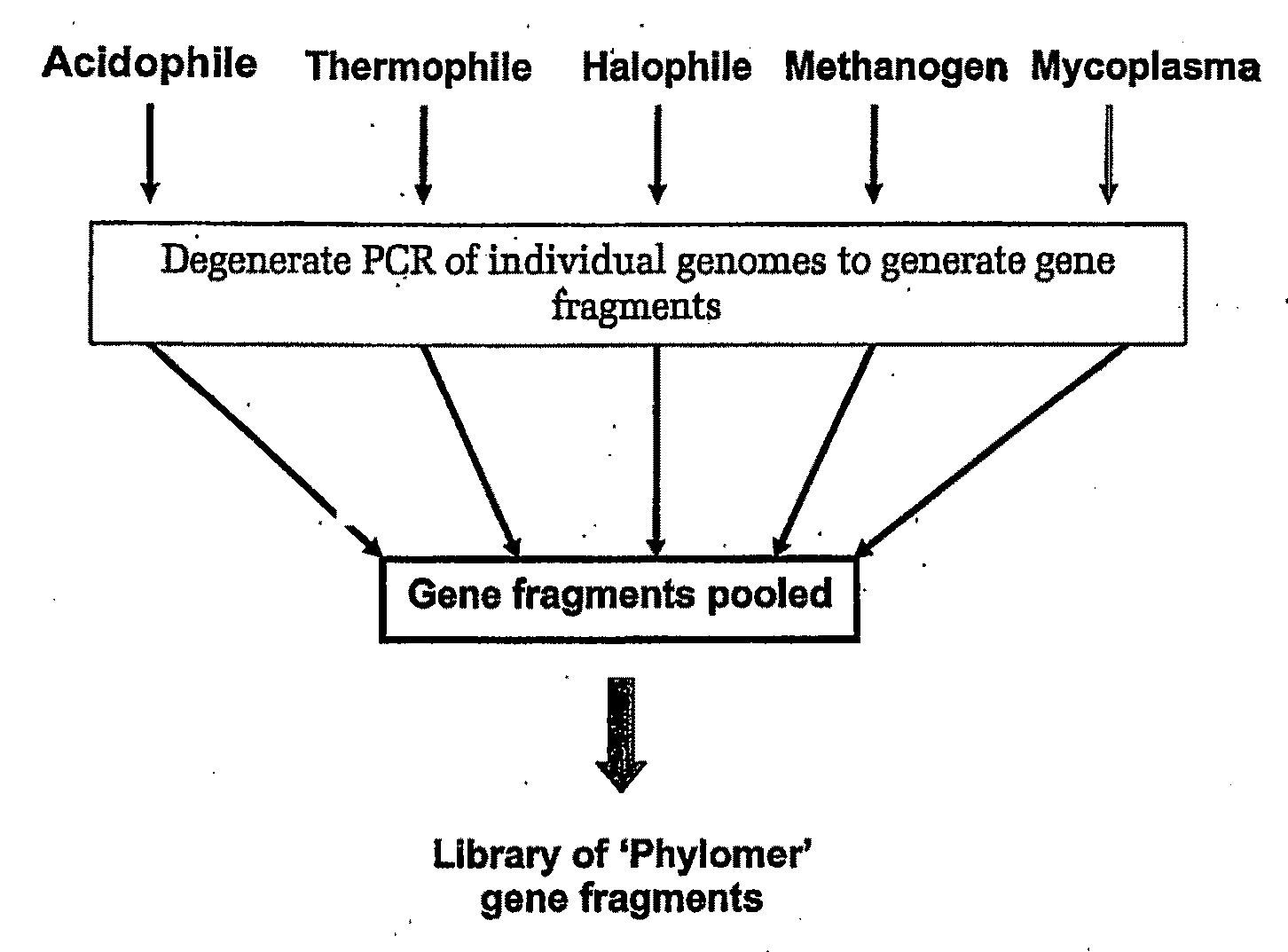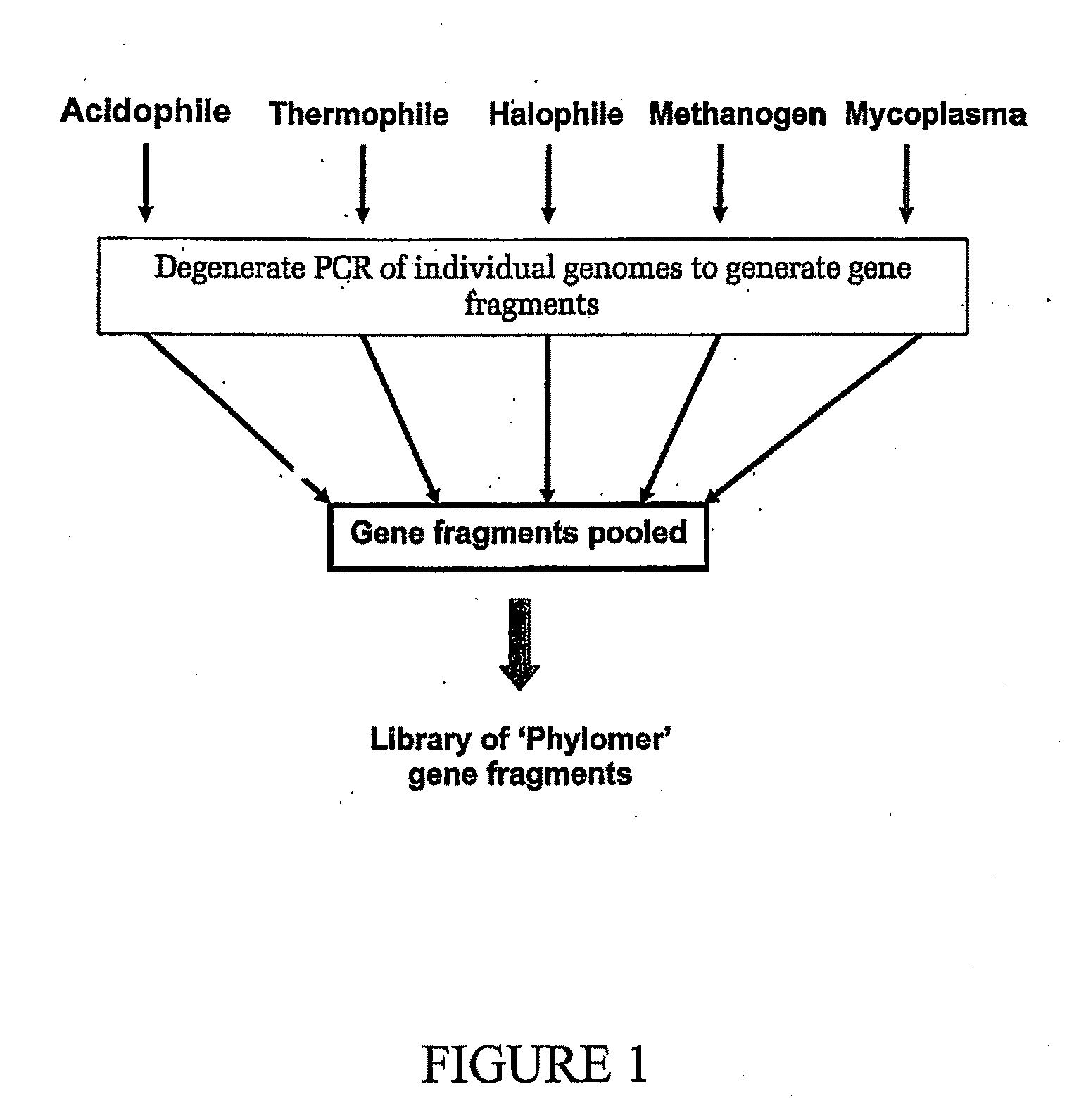Peptide inhibitors of c-jun dimerization and uses thereof
a technology of c-jun dimerization and inhibitors, which is applied in the field of peptide inhibitors of c-jun dimerization, can solve the problems of reducing the appeal of peptides as therapeutic agents, peptides often showing little or none of the secondary or tertiary structure required for efficient binding, and their more rapid degradation and clearance, so as to improve the structural consideration
- Summary
- Abstract
- Description
- Claims
- Application Information
AI Technical Summary
Benefits of technology
Problems solved by technology
Method used
Image
Examples
example 1
The Construction of a Biodiverse Nucleic Acid Fragment Expression Library in the Vector pDEATH-Trp
[0515]Nucleic acid was isolated from the following bacterial species:
1Archaeoglobus fulgidis2Aquifex aeliticus3Aeropyrum pernix4Bacillus subtilis5Bordetella pertussis TOX66Borrelia burgdorferi7Chlamydia trachomatis8Escherichia coli K129Haemophilus influenzae (rd)10Helicobacter pylori11Methanobacterium thermoautotrophicum12Methanococcus jannaschii13Mycoplasma pneumoniae14Neisseria meningitidis15Pseudomonas aeruginosa16Pyrococcus horikoshii17S nechosistis PCC 680318Thermoplasma volcanium19Thermotoga maritima
[0516]Nucleic acid fragments were generated from the genomic DNA of each genome using 2 consecutive rounds of primer extension amplification using tagged random oligonucleotides with the sequence:
5′-GACTACAAGGACGACGACGACAAGGCTTATCAATCAATCAN6-S′ (SEQ ID NO: 38). The PCR amplification was completed using the Klenow fragment of E. coli DNA polymerase I in the following primer extension re...
example 2
Characterization of a Biodiverse Nucleic Acid Fragment Expression Library in the pDEATH-Trp Vector
[0544]Sequence analysis of nucleic acids cloned into pDEATH-Trp vector show that the fragments are derived from a variety of organisms, and encode a variety of proteins, as shown in Table 2.
TABLE 2Characterization of nucleic acid fragment cloned into pDEATH-TrpInsertsizeGenbankNo.(bp)OrganismIDFunction1114P. aeruginosaAAG05339.1Hypothetical Protein2143SynechocystisBAA10184.1FructosePCC68033166E. coliAAC73742.1Lipoprotein4180B. subtilisCAB12555.1methyl-acceptingchemotaxis protein5150N. meningitisAAF41991.1N utilization substanceprotein A6240E. coliAAC75637.1Hypothetical protein7357H. pyloriAAD08555.1transcription terminationfactor NusA883Z. maritimaAAD36283.1Hypothetical protein
example 3
The Construction of a Biodiverse Nucleic Acid Fragment Expression Library in the Vector T7Select415-1
[0545]Nucleic acid was isolated from the following bacterial species:
1Archaeoglobus fulgidis2Aquifex aeliticus3Aeropyrum pernix4Bacillus subtilis5Bordetella pertussis TOX66Borrelia burgdorferi7Chlamydia trachomatis8Escherichia coli K129Haemophilus influenzae (rd)10Helicobacter pylori11Methanobacterium thermoautotrophicum12Methanococcus jannaschii13Mycoplasma pneumoniae14Neisseria meningitidis15Pseudomonas aeruginosa16Pyrococcus horikoshii17Synechosistis PCC 680318Thermoplasma volcanium19Thermotoga maritima
[0546]Nucleic acid fragments were generated from each of these genomes using multiple consecutive rounds of Klenow primer extension using tagged random oligonucleotides.
[0547]In the final round of PCR, the sequence of the oligonucleotide primer comprised the sequence:
(SEQ ID NO: 42)5′-AGAGGAATTCAGGTCAGACTACAAGGACGACGACGACAAG-S′.
[0548]The primer extension products generated were then...
PUM
| Property | Measurement | Unit |
|---|---|---|
| Volume | aaaaa | aaaaa |
| Volume | aaaaa | aaaaa |
| Volume | aaaaa | aaaaa |
Abstract
Description
Claims
Application Information
 Login to View More
Login to View More - R&D
- Intellectual Property
- Life Sciences
- Materials
- Tech Scout
- Unparalleled Data Quality
- Higher Quality Content
- 60% Fewer Hallucinations
Browse by: Latest US Patents, China's latest patents, Technical Efficacy Thesaurus, Application Domain, Technology Topic, Popular Technical Reports.
© 2025 PatSnap. All rights reserved.Legal|Privacy policy|Modern Slavery Act Transparency Statement|Sitemap|About US| Contact US: help@patsnap.com



